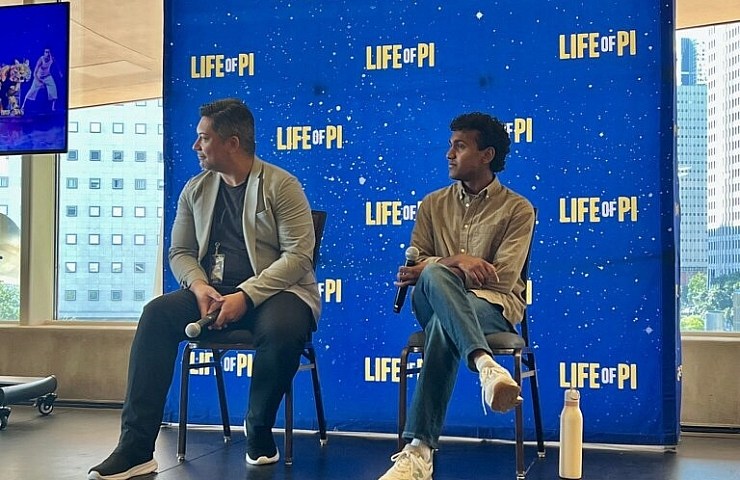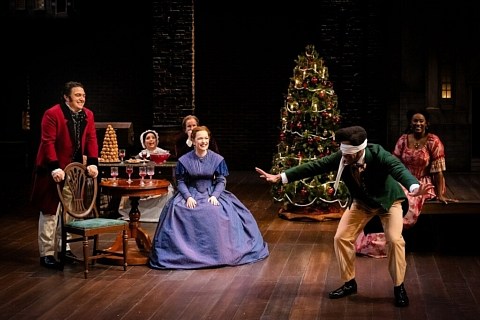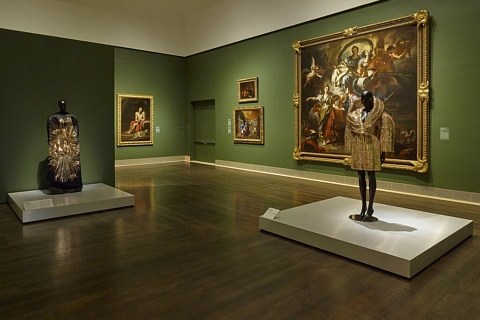Following the opening night of “Life of Pi” at the Hobby Center, a panel discussion was held on Wednesday, Aug. 20, 2025, to discuss “Life of Pi” and the making of it.
The panel was moderated by Sheri Johnson, general manager, Broadway at the Hobby Center.
The panel consisted of the U.S. associate Puppetry & Movement Director and Resident Director Jon Hoche. It also included Savidu Geevaratne, who played Pi, as well as Toussaint Jeanlouis, Shiloh Goodin and Austin Wong Harper, who puppeteered the head, heart and hind, respectively, of Richard Parker the tiger.
During the panel, the tiger appeared prowling around the room, jumping on top of a chair and laying down on the panel stage.
Cooglife asked how they balanced the powerful presence of Richard Parker and Pi without one overshadowing the other in the “Life of Pi.”
Hoche explained the dynamic between Pi and Richard Parker as a symbiotic relationship. The balance is reflected from the writing, blocking and the acting between the two characters.
The two characters spend a lot of time on stage together. So, the play made sure to indicate the progression of their relationship throughout the story.
The tiger knows he is more powerful and has the strength to do much more. Jeanlouis said it is about listening when he is operating the head of the tiger.
During the boat scene when Pi is digging in the water, Jeanlouis tries to mirror Pi’s actions when moving the Tiger. When Pi is looking in the water he will look down at the water. Then, both characters will slowly look at each other and then back out at the water. This shows that the two opposing characters are not so different after all.
“I always see the tiger is already inside of Pi,” said Jeanlouis. “Sometimes I think about how you have to tap into your own animal to get through life and get through things like trauma experiences. There is no way for me or us to take over him. We are him.”
Following the panel, Geevaratne and Hoche talked about the audition process and the show’s underlying message and relevance today.
Hoche said “Life of Pi” is more than just a play. It has musical elements in it as well.
The story is unique and rich. So,they needed to incorporate all the visual and theatrical elements to do it justice.
They looked at the script and the story itself and then built on top of that to see what music, projections, puppets and sound effects were needed.
Through the early development of the play, Hoche balanced the artistic integrity of previous “Life of Pi” shows, while allowing the actors and the puppeteers to make it feel new and exciting every night.
The chemistry within the cast, including the three-man team behind the tiger, is intuitive and creates a believable dynamic between all the characters.
Geevaratne explained the chemistry was built through the actors’ natural friendship and collaboration throughout the process.
Chemistry was a natural progression after spending months on the road together, including eating lunch and going on hikes together.
Geevaratne recalled first seeing the show in 2022 or 2023. So, when he found out the show was going on tour in 2025, he let his manager know his intentions of being in it.
After sending in a self-tape, he was involved in a week of puppetry auditions.
He was put through a 45-minute workout to see what his physicality was. Later he did some puppetry exercises with the tiger to see what their interactions would be.
Much time passed. Then, Geevaratne was asked to come back and do it all again.
Hoche remembered meeting him in the weeklong audition and appreciated how collaborative and open he was. Geevaratne stood out to him because he was able to work with what was in front of him instead of what was given to him.
Eventually, Geevaratne got the call. He had booked the role of Pi.
Geevaratne was naturally curious as a child, asking millions of questions. Adults would tell him to ask someone else as a way to pacify him.
It is this youthful curiosity and the belief that rules should not stop you from finding answers that he brought to the character Pi.
He grew up Buddhist, but explained his relationship with faith was more related to his culture than his own beliefs. Geevaratne explained that, through the show, he has become more of a believer and a believer in how religion can help people hope.
He remembered how the people who wrote the Bible and the Quran dealt with famine, no running water and people dying at young ages, yet they looked toward faith to carry them through and give them hope.
“I’ve come to appreciate religion more in that context and the idea that belief and story are this powerful thing that helps people and hope and dream,” said Geevaratne.
Despite playing opposite a fake tiger, it was not difficult for Geevaratne to imagine a real one. The puppetry looked like a tiger and acted like a tiger, which made it easier to envision encountering an actual tiger.
Through research and deep listening, Geevaratne learned specific ways he would react if he were around a live tiger. For instance, instead of moving into a hunch position, a person would not move at all.
Geevaratne loves when the tiger team does something different from what is scripted, because it allows him to improvise and makes the scene feel fresh and lively.
“Theater is made alive by things that are happening right now,” said Geevaratne.
Hoche explains this story, at its core, is about immigration. This kind of story is always relevant and has never truly gone away.
In “Life of Pi”, Pi and his family board a ship with all the animals from his father’s zoo and flee India for a better life, leaving behind political unrest and chaos.
Geevaratne appreciates how the story sheds light on the fact that people around the world experience extraordinary things.
People who have gone through this connect with the story. Just like Pi, they have gone through traumatic experiences and people would not believe the reality they lived through.
Geevaratne said it can be freeing to see someone fight for a better life. Plus, the audience can also get some release and hope from it.
In “Life of Pi”, Pi recounts an extravagant story about how he survived on a lifeboat for 227 days with a tiger.
When Pi is interviewed about what happened to him, the interviewer does not believe the story he was telling. Instead, the interviewer writes in his report a version that is perceived as more believable.
The play leaves the audience questioning which story they believe. So, we asked Geevaratne and Hoche which story they believe to be true.
Geevaratne playfully responded that he would never tell.
Hoche said, while he believes one story to be true, he believes the other story.
Geevaratne said the message they want to get across in this story is about storytelling itself. Stories are powerful and can keep people alive. “And it shouldn’t be written off just because it’s a story, just because the facts aren’t super clear,” said Geevaratne.
Ultimately, they leave the interpretation up to the audience without answering.
Hoche aims to confirm to the audience that theater is a transformative art form through “Life of Pi.”
Hoche explained that people who come to see their show leave different.
“I love the idea that we are presenting questions. We are making them think so that conversations continue as they leave. I think that’s what good art really does,” said Hoche.
These are the kinds of plays Geevaratne and Hoche like to be involved in—the plays that make people leave thinking about what they saw.
Their goal is to share the experience with the audience by allowing them to have an active role in the process. They use entertainment to draw them in. Once they are comfortable, their goal is to present them with a certain topic and examine it.
They love that at the end of the performance, it is not parents who are asking their kids what they loved about the play. It is the kids asking their parents what they thought of the story’s message.





Recent Comments